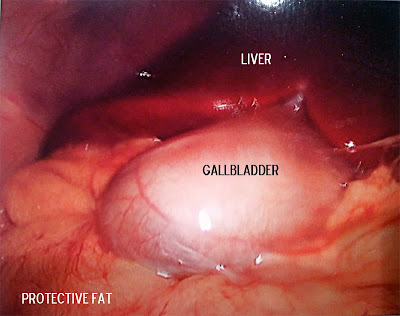** Video is not for the faint hearted as I discovered :S **
Sunday, 22 September 2013
Laparoscopic Cholecystectomy (Surgical Procedure)
Cholecystectomy is the surgical removal of the gallbladder. It is a common treatment of symptomatic gallstones and other gallbladder conditions. Surgical options include the standard procedure, called laparoscopic cholecystectomy, and an older more invasive procedure, called open cholecystectomy.
Labels:
bile,
Cholecystectomy,
clean eating,
digest,
digestaid,
eagle,
fitness,
fitspo,
gallbladder,
greenridge,
health,
liverplex,
livertonic,
nutrition,
post surgery,
toxins,
wellbeing,
wellness
Saturday, 21 September 2013
What happens when you don’t have a gallbladder?
My liver will continue to make bile, but there is no longer a place to store it or concentrate it. Therefore bile continually slowly trickles into the intestines. If I eat a fatty meal, I will not be able to secrete a large enough amount of bile into my intestines, therefore the fat will be poorly digested. This means many people experience diarrhea, bloating, nausea or indigestion.
Not digesting fat means I will not be able to digest essential fatty acids, including omega 3 and omega 6 fats. It also means I have a hard time absorbing fat soluble vitamins such as vitamins D, E, A and K. These nutrients are vital for good health, and I will need to take a supplement such EAGLE Digestaid and Greenridge Liverplex to support digestion.
Labels:
bile,
Cholecystectomy,
clean eating,
digest,
digestaid,
eagle,
fitness,
fitspo,
gallbladder,
greenridge,
health,
liverplex,
livertonic,
nutrition,
post surgery,
sugar,
toxins,
wellbeing,
wellness
Friday, 20 September 2013
What is Bile?
Bile or gall is a bitter-tasting, dark green to yellowish brown fluid, produced by the liver of most vertebrates, that aids the digestion of lipids in the small intestine.
In many species, bile is stored in the gallbladder and, when the organism eats, is discharged into the duodenum. Bile is 85% water, 10% bile salts, 3% mucus and pigments, 1% fats, and 0.7% inorganic salts.
| Secretion of bile |
Thursday, 19 September 2013
Do you know what a Gallbladder is?
To begin my story, below I am going to briefly explain the role and importance of the Gallbladder before I begin to emphasis the importance of health, fitness, and well-being when it has been removed.
The Gallbladder stores and concentrates bile from the liver, and releases into the small intestine to further digest food there.
It collects around 50mls of bile, which is discharged when food containing fat enters the digestive tract, stimulating the secretion of cholecystokinin (CCK-peptide hormone of the gastrointestinal system responsible for stimulating the digestion of fat and protein). The bile, produced in the liver, emulsifies fats and neutralizes acids in partly digested food.
After being collected in the Gallbladder, the bile becomes more concentrated than when it left the liver, increasing its potency and intensifying its effect on fats. Most digestion occurs in the upper intestine, or, the duodenum, where the bile is released.
 |
 |
Tuesday, 10 September 2013
My first blog!
Hi peeps!
Well this is my first post for my new account. Very excited about what the future holds! I am dedicating this blog to health, fitness, nutrition and most importantly life post Cholecystectomy surgery (Gallbladder removal)
Enjoy, read along and share your thoughts and feelings with me as we motor along this journey together!
Angela x
Subscribe to:
Comments (Atom)

